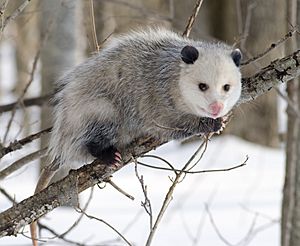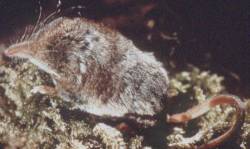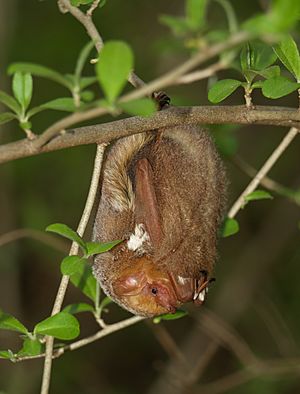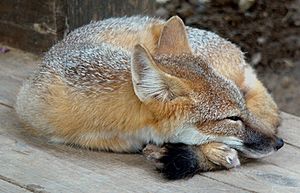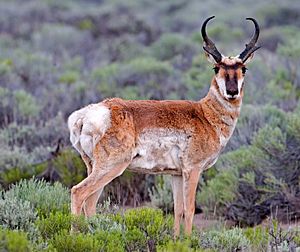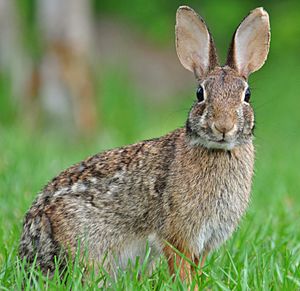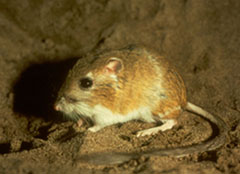List of mammals of South Dakota facts for kids
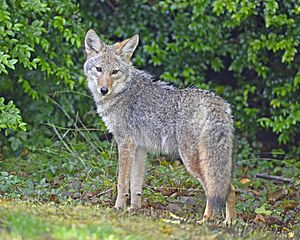
Welcome to the amazing world of mammals living in South Dakota! This list will introduce you to all the different kinds of furry creatures that call this U.S. state home. From tiny shrews to mighty bison, South Dakota has a wide variety of mammals.
Some animals, like the mountain goat, gray wolf, and grizzly bear, used to live here but are no longer found in the wild within the state. We call these "extirpated" species. In total, South Dakota is home to or was once home to about 86 different mammal species. Let's explore them!
Contents
Meet the Mammals of South Dakota
Marsupials: The Pouched Mammals
Did you know some mammals carry their babies in a pouch? These are called marsupials!
Opossums
- Virginia opossum, Didelphis virginiana
The Virginia opossum is the only marsupial found in North America. They are known for "playing dead" when scared!
Insect-Eaters: Shrews and Moles
These small mammals have a special diet, mostly eating insects and other tiny creatures.
Shrews
Shrews are some of the smallest mammals on Earth! They have long snouts and tiny eyes.
- Northern short-tailed shrew, Blarina brevicauda
- Least shrew, Cryptotis parva
- Arctic shrew, Sorex arcticus
- Masked shrew, Sorex cinereus
- American pygmy shrew, Sorex hoyi (This tiny shrew might not live here anymore.)
- Dwarf shrew, Sorex nanus
- American water shrew, Sorex palustris
Moles
Moles are amazing diggers! They spend most of their lives underground, creating tunnels.
- Eastern mole, Scalopus aquaticus
Bats: Mammals of the Night Sky
Bats are the only mammals that can truly fly! They use echolocation to find their way and hunt insects in the dark.
Vespertilionidae (Common Bats)
- Big brown bat, Eptesicus fuscus
- Eastern red bat, Lasiurus borealis
- Hoary bat, Lasiurus cinereus
- Silver-haired bat, Lasionycteris noctivagans
- Keen's myotis, Myotis keenii
- Fringe-tailed bat, Myotis thysanodes
- Little brown bat, Myotis lucifugus
- Townsend's big-eared bat, Plecotus townsendii
Carnivores: Hunters of the Wild
Carnivores are animals that primarily eat meat. This group includes many well-known predators.
Canidae (Dogs, Wolves, and Foxes)
- Coyote, Canis latrans
Coyotes are very adaptable and can be found in many different habitats.
- Gray wolf, Canis lupus (These wolves no longer live in South Dakota's wild.)
- Northern Rocky Mountain wolf, C. l. irremotus (Extirpated)
- Great Plains wolf, C. l. nubilus
- Gray fox, Urocyon cineroeargenteus
- Swift fox, Vulpes velox
Swift foxes are smaller and faster than other foxes.
- Red fox, Vulpes vulpes
Felidae (Cats)
- Bobcat, Lynx rufus
Bobcats are wild cats named for their short, "bobbed" tails.
- Cougar, Puma concolor
Cougars are large, powerful wild cats, also known as mountain lions.
Procyonidae (Raccoons)
- Raccoon, Procyon lotor
Raccoons are known for their masked faces and clever paws.
Mephitidae (Skunks)
Skunks are famous for their strong-smelling spray, which they use to defend themselves.
- Striped skunk, Mephitis mephitis
- Eastern spotted skunk, Spilogale putorius
Mustelidae (Weasels, Otters, Badgers, and Ferrets)
This family includes many sleek and agile hunters.
- North American river otter, Lontra canadensis
River otters are playful animals that love to swim.
- Black-footed ferret, Mustela nigripes (These ferrets have been brought back to South Dakota.)
- Least weasel, Mustela nivalis
- Long-tailed weasel, Neogale frenata
- American mink, Neogale vison
- American badger, Taxidea taxus
Badgers are strong diggers with sharp claws.
Ursidae (Bears)
- American black bear, Ursus americanus
Black bears are the most common bears in North America.
- Brown bear, Ursus arctos (Brown bears, including grizzlies, no longer live in South Dakota's wild.)
- Grizzly bear, U. a. horribilis (Extirpated)
Hoofed Mammals: Artiodactyla
These mammals have hooves and an even number of toes. Many of them are grazers, eating plants.
Antilocapridae (Pronghorn)
- Pronghorn, Antilocapra americana
Pronghorns are the fastest land animals in North America.
Bovidae (Bison, Sheep, and Goats)
- American bison, Bison bison (Bison have been reintroduced to South Dakota.)
- Plains bison, B. b. bison (Reintroduced)
Bison are the largest land mammals in North America.
- Bighorn sheep, Ovis canadensis
Bighorn sheep are known for the large, curved horns of the males.
- Mountain goat, Oreamnos americanus (These goats were brought to South Dakota by people.)
Cervidae (Deer, Elk, and Moose)
Elk are large deer with impressive antlers.
- Mule deer, Odocoileus hemionus
Mule deer have large ears that look like a mule's.
- White-tailed deer, Odocoileus virginianus
White-tailed deer are common and named for the white underside of their tail.
Lagomorphs: Rabbits and Hares
Lagomorphs look a bit like rodents but have two pairs of incisors (front teeth) in their upper jaw, not one.
Leporidae (Rabbits and Hares)
- Black-tailed jackrabbit, Lepus californicus
- White-tailed jackrabbit, Lepus townsendii
- Desert cottontail, Sylvilagus audubonii
- Eastern cottontail, Sylvilagus floridanus
- Mountain cottontail, Sylvilagus nuttalii
Rodents: Gnawing Mammals
Rodents are the largest group of mammals. They are known for their continuously growing front teeth, which they keep short by gnawing.
Castoridae (Beavers)
- American beaver, Castor canadensis
Beavers are amazing engineers, building dams and lodges.
Cricetidae (New World Mice and Voles)
- Southern red-backed vole, Clethrionomys gapperi
- Sagebrush vole, Lemmiscus curtatus
- Long-tailed vole, Microtus longicaudus
- Prairie vole, Microtus ochrogaster
- Western meadow vole, Microtus drummondii
- Bushy-tailed woodrat, Neotoma cinerea
- Muskrat, Ondatra zibethicus
Muskrats are semi-aquatic rodents, similar to small beavers.
- Northern grasshopper mouse, Onychomys leucogaster
- White-footed mouse, Peromyscus leucopus
- Western deer mouse, Peromyscus sonoriensis
- Western harvest mouse, Reithrodontomys megalotis
- Plains harvest mouse, Reithrodontomys montanus
Erethizontidae (Porcupines)
- North American porcupine, Erethizon dorsatum
Porcupines are known for their sharp quills, which they use for defense.
Geomyidae (Pocket Gophers)
Pocket gophers are burrowing rodents with large cheek pouches for carrying food.
- Plains pocket gopher, Geomys bursarius
- Northern pocket gopher, Thomomys talpoides
Heteromyidae (Kangaroo Rats and Pocket Mice)
- Hispid pocket mouse, Chaetodipus hispidus
- Ord's kangaroo rat, Dipodomys ordii
Kangaroo rats can jump very far and live in dry areas.
- Olive-backed pocket mouse, Perognathus fasciatus
- Plains pocket mouse, Perognathus flavescens
Muridae (Old World Mice and Rats)
These species were introduced to North America by humans.
- House mouse, Mus musculus (Introduced)
- Norway rat, Rattus norvegicus (Introduced)
Sciuridae (Squirrels, Chipmunks, and Marmots)
This family includes many familiar bushy-tailed animals.
- Least chipmunk, Eutamias minimus
- Black-tailed prairie dog, Cynomys ludovicianus
Prairie dogs live in large colonies called "towns."
- Southern flying squirrel, Glaucomys volans
- Northern flying squirrel, Glaucomys sabrinus
Flying squirrels don't truly fly, but glide using a special membrane.
- Yellow-bellied marmot, Marmota flaviventris
- Groundhog, Marmota monax
Groundhogs are large rodents known for their burrowing habits.
- Fox squirrel, Sciurus niger
- Franklin's ground squirrel, Spermophilus frankinii
- Richardson's ground squirrel, Spermophilus richardsonii
- Spotted ground squirrel, Spermophilus spilosoma
- Thirteen-lined ground squirrel, Spermophilus tridecemlineatus
- Eastern chipmunk, Tamias striatus
- American red squirrel, Tamiasciurus hudsonicus
Zapodidae (Jumping Mice)
Jumping mice have long tails and powerful hind legs that help them leap.
- Meadow jumping mouse, Zapus hudsonius
- Western jumping mouse, Zapus princeps
More to Explore
- List of prehistoric mammals
- Lists of mammals by region
- Mammal classification


